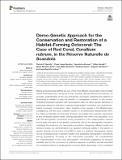Por favor, use este identificador para citar o enlazar a este item:
http://hdl.handle.net/10261/248118COMPARTIR / EXPORTAR:
 SHARE SHARE
 CORE
BASE CORE
BASE
|
|
| Visualizar otros formatos: MARC | Dublin Core | RDF | ORE | MODS | METS | DIDL | DATACITE | |

| Título: | Demo-Genetic Approach for the Conservation and Restoration of a Habitat-Forming Octocoral: The Case of Red Coral, Corallium rubrum, in the Réserve Naturelle de Scandola |
Autor: | Gazulla, Carlota R.; López-Sendino, P. CSIC ORCID ; Antunes, Agostinho; Aurelle, Didier; Montero-Serra, Ignasi CSIC ORCID CVN; Dominici, Jean-Marie; Linares, Cristina CSIC ORCID; Garrabou, Joaquim CSIC ORCID ; Ledoux, J. B. CSIC ORCID | Palabras clave: | Corallium rubrum Temperate habitat-forming octocoral Marine protected area Demo-genetics Connectivity Spatial genetic structure Demographic transition Marine restoration |
Fecha de publicación: | jun-2021 | Editor: | Frontiers Media | Citación: | Frontiers in Marine Science 8: 633057 (2021) | Resumen: | Marine protected areas (MPAs) are one of the most efficient conservation tools to buffer marine biodiversity loss induced by human activities. Beside effective enforcement, an accurate understanding of the eco-evolutionary processes underlying the patterns of biodiversity is needed to reap the benefits of management policies. In this context, integrating population genetics with demographic data, the demo-genetic approach, is particularly relevant to shift from a “species-based pattern” toward an “eco-evolutionary-based processes” conservation. Here, targeting a key species in the Mediterranean coralligenous, the red coral, Corallium rubrum, in an emblematic Mediterranean MPA, the “Réserve Naturelle de Scandola” (France), we applied demo-genetic approaches at two contrasted spatial scales, among populations and within one population, to (i) infer the demographic connectivity among populations in the metapopulation network and (ii) shed new light on the genetic connectivity and on the demographic transitions underlying the dynamics of a near-pristine population. Integrating different spatial and temporal scales, we demonstrated (i) an apparent temporal stability in the pattern of genetic diversity and structure in the MPA in spite of a dramatic demographic decline and (ii) contrasted levels of genetic isolation but substantial demographic connectivity among populations. Focusing on the near-pristine population, we complemented the characterization of red coral demographic connectivity suggesting (iii) temporal variability and (iv) the occurrence of collective dispersal. In addition, we demonstrated (v) contrasted patterns of spatial genetic structure (SGS), depending on the considered stage-class (adults vs. juveniles), in the near-pristine population. This last result points out that the overall SGS resulted from a restricted dispersal of locally produced juveniles (SGS among adults and juveniles) combined to mortality during early life stages (decrease of SGS from juveniles to adults). Demonstrating the occurrence of two management units and the importance of two populations (CAVB and ALE) for the network of connectivity, we made recommendations for the management of the Réserve Naturelle de Scandola. Besides, we contributed to the implementation of scientifically driven restoration protocols in red coral by providing estimates for the size, density, and distances among patches of transplanted colonies | Descripción: | 15 pages, 3 figures, 2 tables, supplementary material https://www.frontiersin.org/articles/10.3389/fmars.2021.633057/full#supplementary-material.-- Data Availability Statement:The original contributions presented in the study are included in the article/Supplementary Material, further inquiries can be directed to the corresponding author/s | Versión del editor: | https://doi.org/10.3389/fmars.2021.633057 | URI: | http://hdl.handle.net/10261/248118 | DOI: | 10.3389/fmars.2021.633057 | E-ISSN: | 2296-7745 |
| Aparece en las colecciones: | (ICM) Artículos |
Ficheros en este ítem:
| Fichero | Descripción | Tamaño | Formato | |
|---|---|---|---|---|
| Gazulla_et_al_2021.pdf | 1,48 MB | Adobe PDF |  Visualizar/Abrir | |
| Gazulla_et_al_2021_suppl.DOCX | 314,65 kB | Microsoft Word XML | Visualizar/Abrir |
CORE Recommender
SCOPUSTM
Citations
5
checked on 10-abr-2024
WEB OF SCIENCETM
Citations
4
checked on 26-feb-2024
Page view(s)
73
checked on 22-abr-2024
Download(s)
75
checked on 22-abr-2024
Google ScholarTM
Check
Altmetric
Altmetric
Este item está licenciado bajo una Licencia Creative Commons

